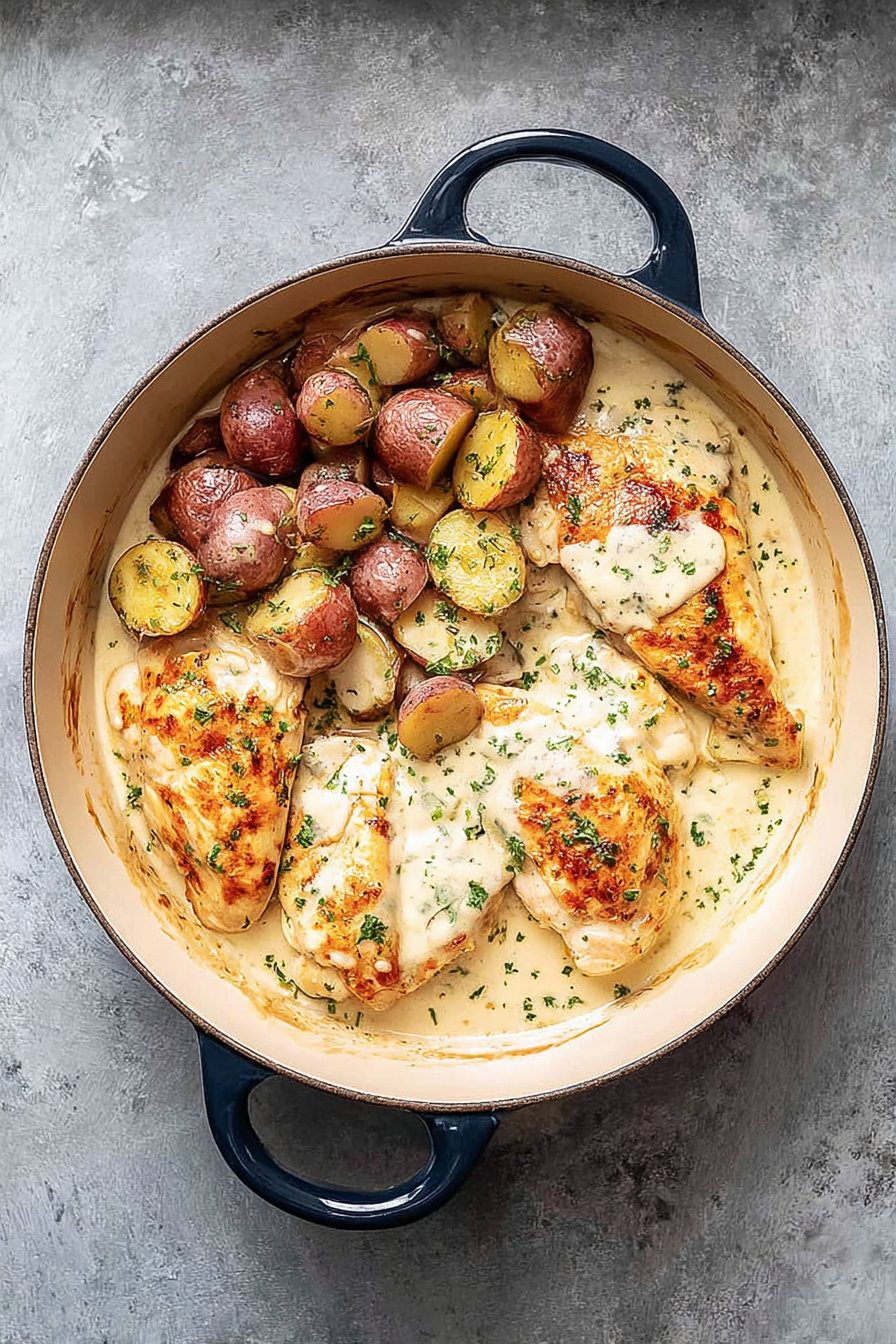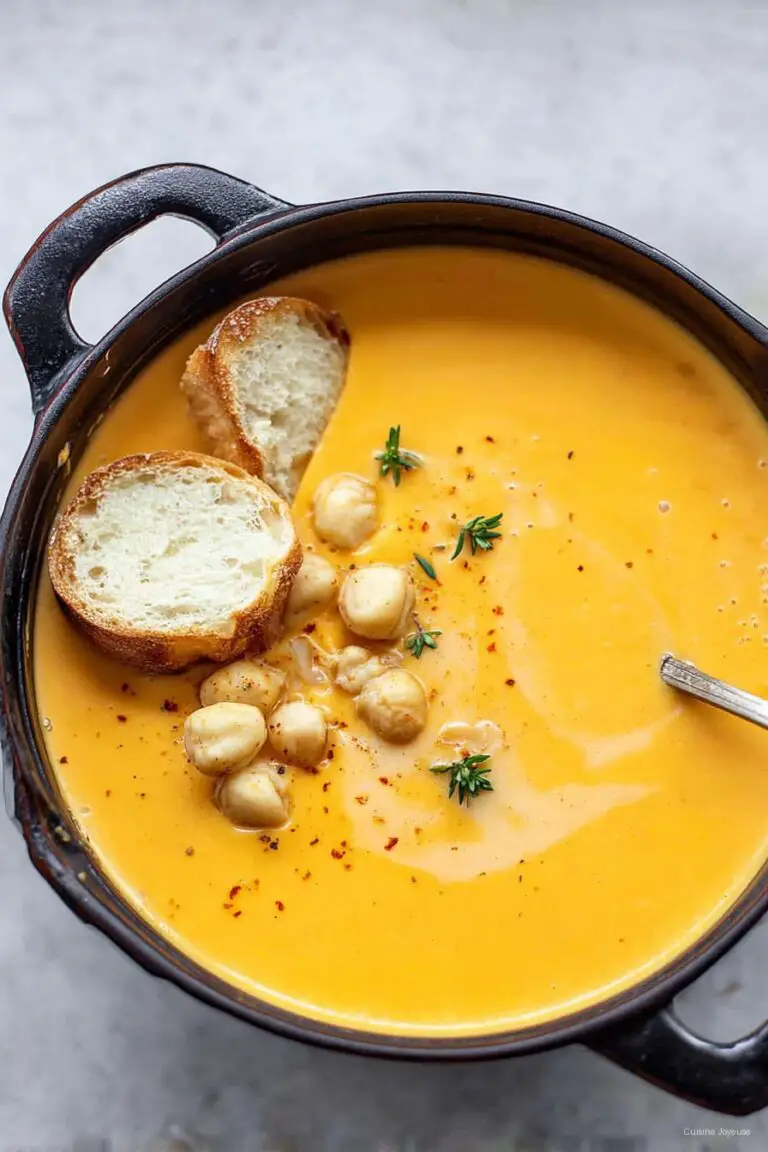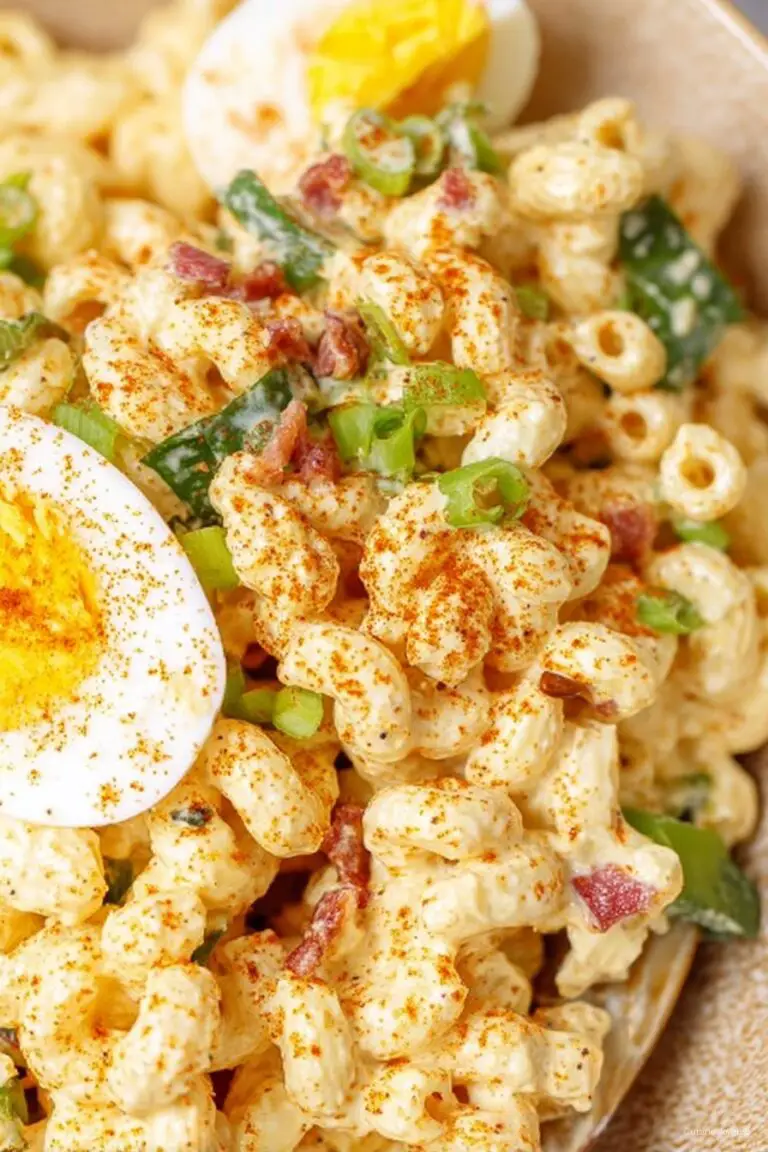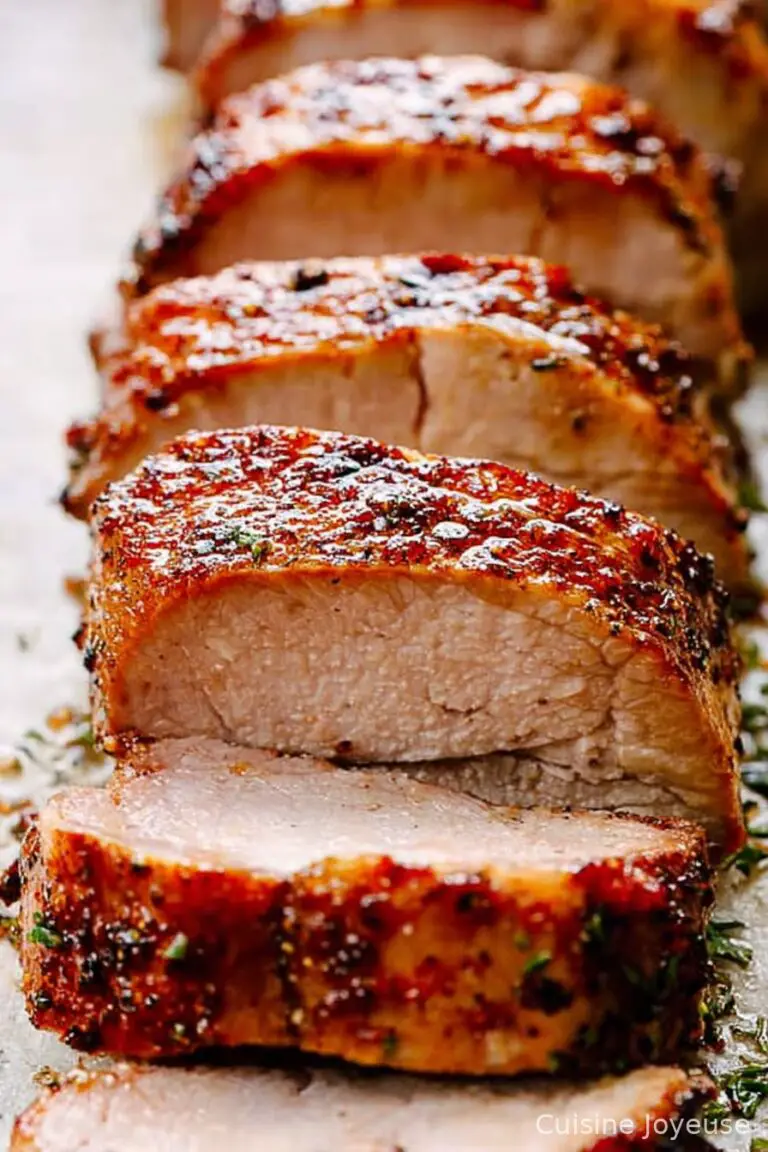Chicken and Potatoes with Dijon Cream Sauce
Okay, Let Me Tell You About This Chicken and Potatoes Thing
I can’t even count how many times I’ve made this Chicken and Potatoes with Dijon Cream Sauce. It’s my ‘oh no, what do I cook tonight’ hero, but also the dish I bring out when I want to look like I’ve got it all together (spoiler: I rarely do). The first time I tried it, I accidentally used a bit too much Dijon—thought I’d ruined dinner—but my husband actually loved it and now sort of expects it extra tangy. Anyway, this is the sort of dinner that feels fancier than the effort you put in, and it’s perfect for a chilly evening or, honestly, a Wednesday when you just can’t with complicated recipes. Also, last time, I spilled cream on the dog. Not essential, but it made for a memorable clean-up.
Why I Keep Making This (And You Probably Will, Too)
I make this when I’m feeling lazy but still want that ‘ooh, you cooked?’ vibe from the family. My kids go crazy for it—well, except for the youngest, who claims potatoes are ‘too lumpy’ (whatever that means). The Dijon sauce is creamy and just fancy enough to trick everyone into thinking I spent hours slaving away. Plus, on nights I can’t face another pot to wash, it’s mostly a one-pan deal. Oh, and if you’re worried about the sauce being too tangy—been there, tasted that—I learned to start with less and add as I go. Save yourself the pucker face.
What You’ll Need (And a Few Cheats)
- 4 chicken thighs (skin-on, bone-in for flavor, but I sometimes use boneless if that’s all I’ve got—just watch the cooking time)
- About 500g potatoes, cut into chunky cubes (Yukon Gold is great, but literally any potato works—I once used sweet potatoes and it was actually pretty good)
- 2 tablespoons olive oil (or, if you’re out, a knob of butter—the world won’t end)
- Salt and black pepper, to taste (my grandmother used to only use sea salt, but honestly, whatever’s in your shaker)
- 1 small onion, diced (red or white, or shallot if you’re feeling posh)
- 3 garlic cloves, minced (I cheat and use the jarred stuff sometimes—don’t tell the food snobs)
- 1/2 cup chicken stock (I’ve been known to just use water with a bouillon cube, and nobody knew)
- 1/2 cup cream (double, heavy, or even half-and-half if you must)
- 2-3 tablespoons Dijon mustard (Grey Poupon is classic, but store brand works—tried it, survived)
- 1 teaspoon dried thyme (fresh is nice, but who actually has that lying around?)
- Optional: Fresh parsley or chives for a sprinkle on top (makes it look like you care)
How I Actually Cook It (Read First, Then Dive In)
- Preheat your oven to 200°C/400°F. Or, if your oven’s like mine and takes its sweet time, start with 180°C and bump it up once you realize it’s not hot enough.
- Heat the olive oil in a big oven-safe skillet over medium-high heat. Sear the chicken thighs, skin-side down first, for about 5-7 minutes. Don’t poke them—let them get that golden crust. Flip and cook another 2-3 minutes. Take them out and set aside for now (on a plate, not just the counter—that got me once).
- Chuck your potato cubes into the same skillet. Give them a good stir to soak up the chicken bits. Add a sprinkle of salt and pepper, and cook for about 5 minutes till they’re just starting to look golden. (It’s okay if they stick a bit, that’s flavor. Or so I tell myself.)
- Move the potatoes to the side, toss in the onion and garlic. Stir for a minute (this is where I always get distracted and nearly burn the garlic, so watch it).
- Pour in the chicken stock and let it bubble for a couple minutes, scraping up anything stuck to the pan. Smells amazing already, right?
- Pour in the cream and swirl in the Dijon mustard. Stir in the thyme. It’ll look kind of odd—creamy, yellowish, steamy—but trust the process. Taste the sauce now (and add more Dijon if you like it with a kick; I usually do—just not too much or you’ll get complaints).
- Nestle the chicken thighs back in, skin-side up. Spoon some sauce over. Pop the whole skillet in the oven (make sure it’s oven-safe—one time I forgot and, well, it wasn’t pretty).
- Bake 25-30 minutes, or until the chicken’s cooked through and potatoes are fork-tender. Sometimes the top gets a little crispy around the edges, which is my favorite part. If your potatoes aren’t quite done, leave it a bit longer—no harm, just check every 5 mins.
- Let it rest for a few minutes out of the oven. Sprinkle with parsley if you remembered. Now’s the time to sneak a taste before anyone sees.
Notes Only a Real Person Would Admit
- I’ve tried using milk in place of cream. It works, but the sauce ends up a bit runny. If you go this route, maybe simmer it a bit longer?
- The sauce can separate if the oven’s too hot. I just stir it all up again before serving—nobody’s noticed yet.
- If your potatoes are cut too big, they’ll take ages. I learned that the hard way while hungry.
Variations (The Good, The Bad, and The “What Was I Thinking”)
- I’ve swapped in pork chops for the chicken. Tasted great, but needed less time in the oven.
- Once, I added a handful of frozen peas during the last 10 minutes. It was… fine. Not my favorite, but hey, it added color.
- Bacon bits on top? Yes, please. I tried turkey bacon once—let’s just say, not my brightest idea.
Do You Need Fancy Equipment?
I love my cast iron skillet for this, but honestly, any oven-safe pan does the trick. If you don’t have one, you can do the stove part in a regular pan and transfer everything to a baking dish. I’ve used a Pyrex dish before—just more to wash, but it works.
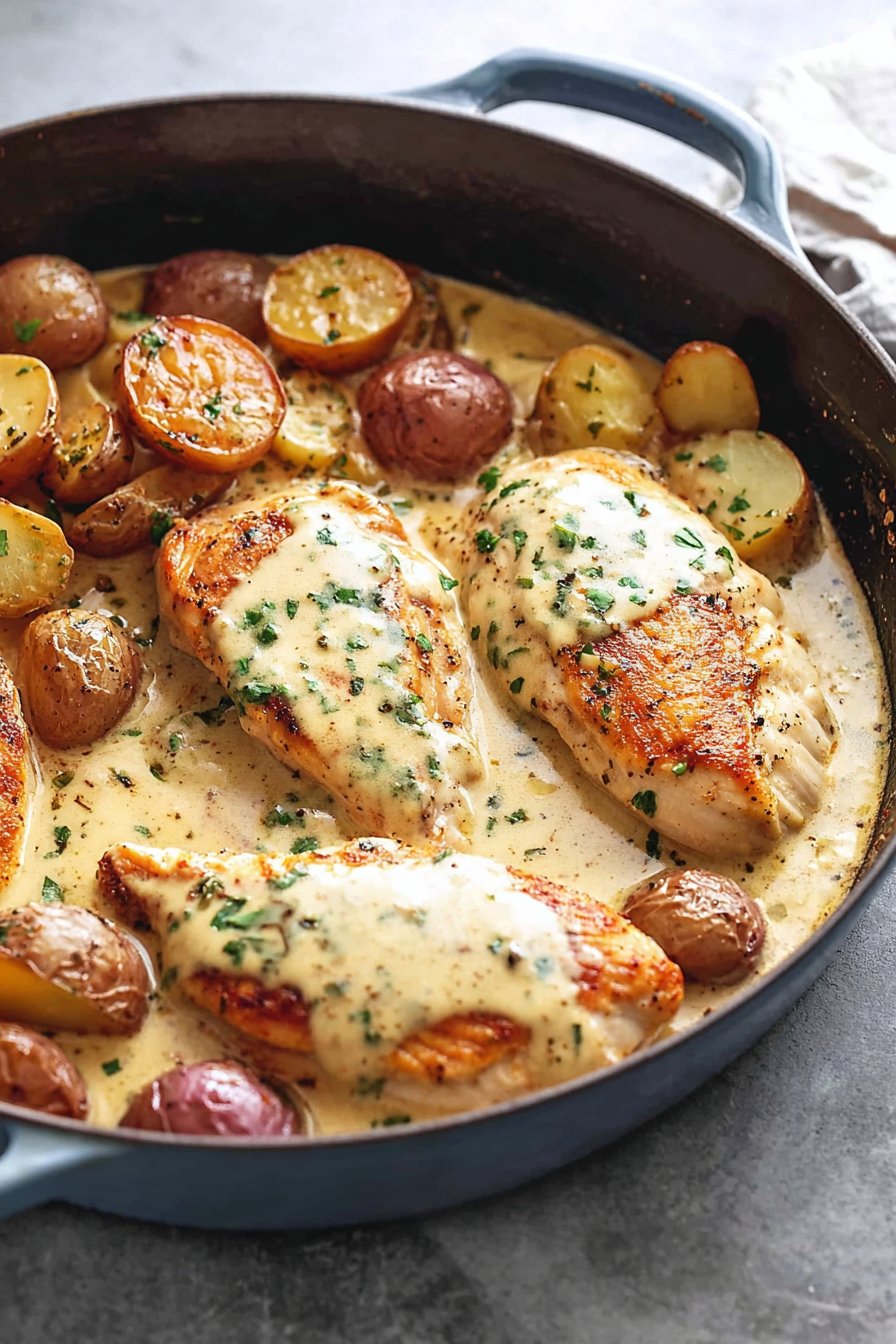
Storing the Leftovers (If There Are Any…)
Pop leftovers into an airtight container, and they’ll keep in the fridge for up to 3 days. I think it actually tastes better the next day, but honestly, in my house it never lasts more than a day! Reheat gently on the stove so the sauce doesn’t get weirdly lumpy. Or, if you’re like me, eat it cold standing by the fridge late at night. No judgment.
How I Like to Serve It (And My Mum’s Way)
Honestly, I just plop the skillet in the middle of the table, hand out some forks, and let everyone dive in. But if you want to be classy, a side of green beans or a simple salad works. My mum always insists on crusty bread to mop up the sauce (she’s right, of course). On special occasions—or if I have guests—I toss in a glass of white wine, both in the sauce and in my hand.
Pro Tips I Learned the Hard Way
- Don’t rush the searing step. I once tried skipping it—huge mistake. The skin ended up floppy. Not a good look.
- Taste the sauce before baking! That way, you can add more Dijon or salt before it’s too late.
- Actually, I find it works better if you let the dish rest a few minutes before serving. The sauce thickens and flavors meld.
FAQ—Stuff People Actually Ask Me
- Can I use chicken breasts instead of thighs?
Yep! Just be careful not to overcook them, or they’ll dry out faster than you can say ‘where’s the sauce?’ - Is there a dairy-free way to make the sauce?
I’ve heard coconut cream works, but honestly, I haven’t tried it yet. If you do, let me know how it turns out! - What’s the best way to reheat leftovers?
Stovetop on low is best. Microwave works, but sometimes the sauce splits. It’s still good, just not as pretty. - Do I have to use Dijon mustard?
Nope, but it’s kinda the point. I did swap in wholegrain mustard once—it was nice, more mellow. English mustard? Waaay too spicy for me, but if you like a kick, go wild. - Can I freeze it?
Technically yes, but the sauce gets a bit weird when thawed. I’d eat it fresh or from the fridge, but that’s just me.
A Little Digression (Because Why Not?)
Oh, and I almost forgot—if you ever find yourself out of potatoes, this sauce is ridiculously good on pasta, too. Learned that during a weird week of nothing in the pantry but Dijon and spaghetti. Sometimes you just gotta roll with it, right?
For more cozy dinner ideas, I sometimes check Smitten Kitchen—Deb’s recipes always work for me, and her chicken stuff is especially good. For potato tips (like, how to get them fluffy inside), Serious Eats has some science-y advice I half-follow. And if you want to nerd out about Dijon, Bon Appétit has a fun write-up on all things mustardy.
Ingredients
- 4 boneless, skinless chicken breasts
- 1.5 pounds baby potatoes, halved
- 2 tablespoons olive oil
- 1 teaspoon salt
- 1/2 teaspoon black pepper
- 2 tablespoons unsalted butter
- 3 cloves garlic, minced
- 1 cup heavy cream
- 2 tablespoons Dijon mustard
- 1/4 cup grated Parmesan cheese
- 2 tablespoons chopped fresh parsley
Instructions
-
1Preheat oven to 400°F (200°C). Season chicken breasts with salt and black pepper.
-
2In a large oven-safe skillet, heat olive oil over medium-high heat. Sear chicken breasts for 2-3 minutes per side until golden. Remove chicken and set aside.
-
3Add potatoes to the skillet and cook for 5 minutes, stirring occasionally. Add butter and garlic, and sauté for 1 minute until fragrant.
-
4Stir in heavy cream, Dijon mustard, and Parmesan cheese. Return chicken to the skillet, nestling it among the potatoes. Spoon some sauce over the chicken.
-
5Transfer the skillet to the oven and bake for 20-25 minutes, or until the chicken is cooked through and potatoes are tender.
-
6Garnish with chopped parsley before serving. Serve hot with extra sauce spooned over the chicken and potatoes.
Approximate Information for One Serving
Nutrition Disclaimers
Number of total servings shown is approximate. Actual number of servings will depend on your preferred portion sizes.
Nutritional values shown are general guidelines and reflect information for 1 serving using the ingredients listed, not including any optional ingredients. Actual macros may vary slightly depending on specific brands and types of ingredients used.
To determine the weight of one serving, prepare the recipe as instructed. Weigh the finished recipe, then divide the weight of the finished recipe (not including the weight of the container the food is in) by the desired number of servings. Result will be the weight of one serving.
Did you make this recipe?
Please consider Pinning it!!

